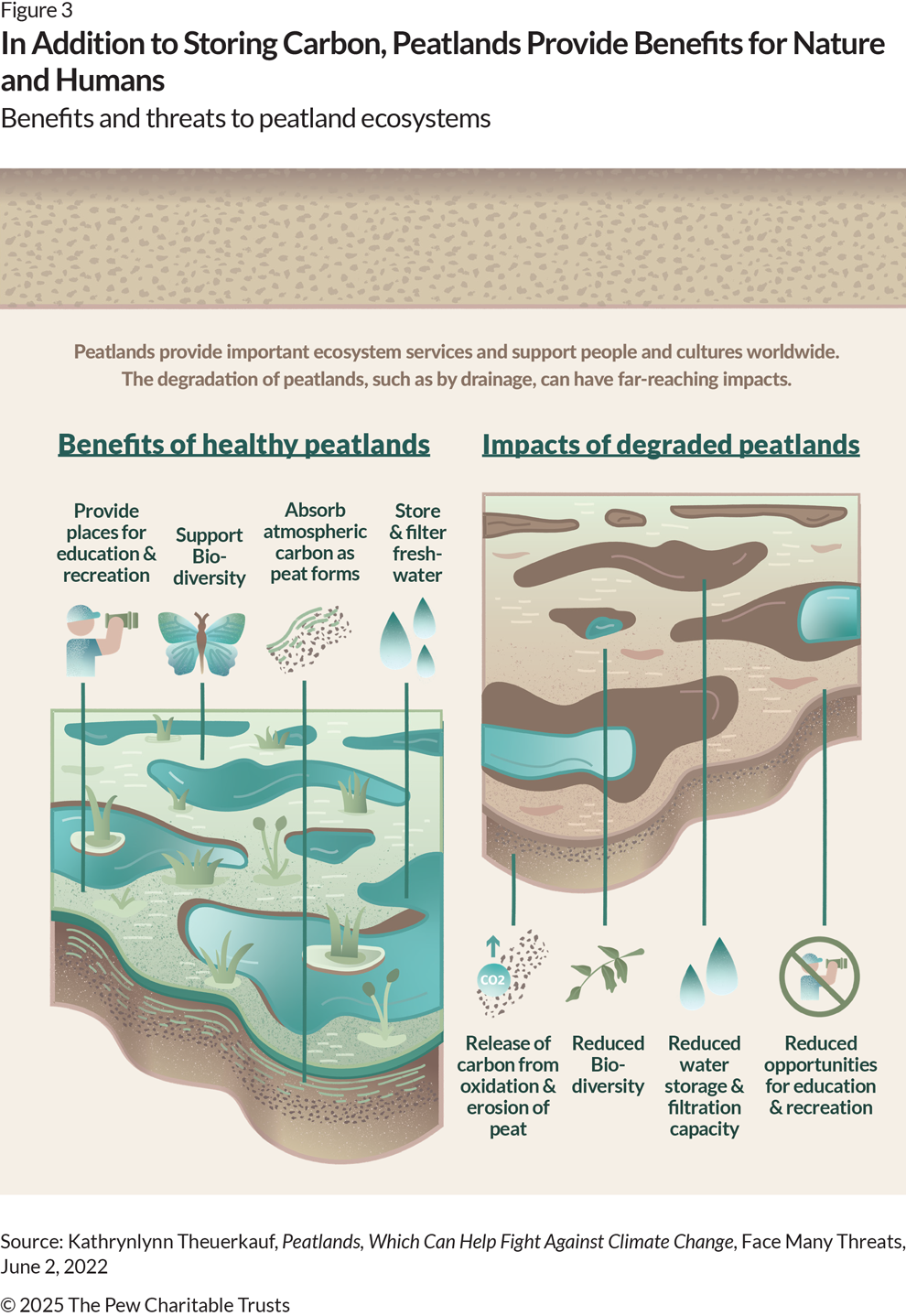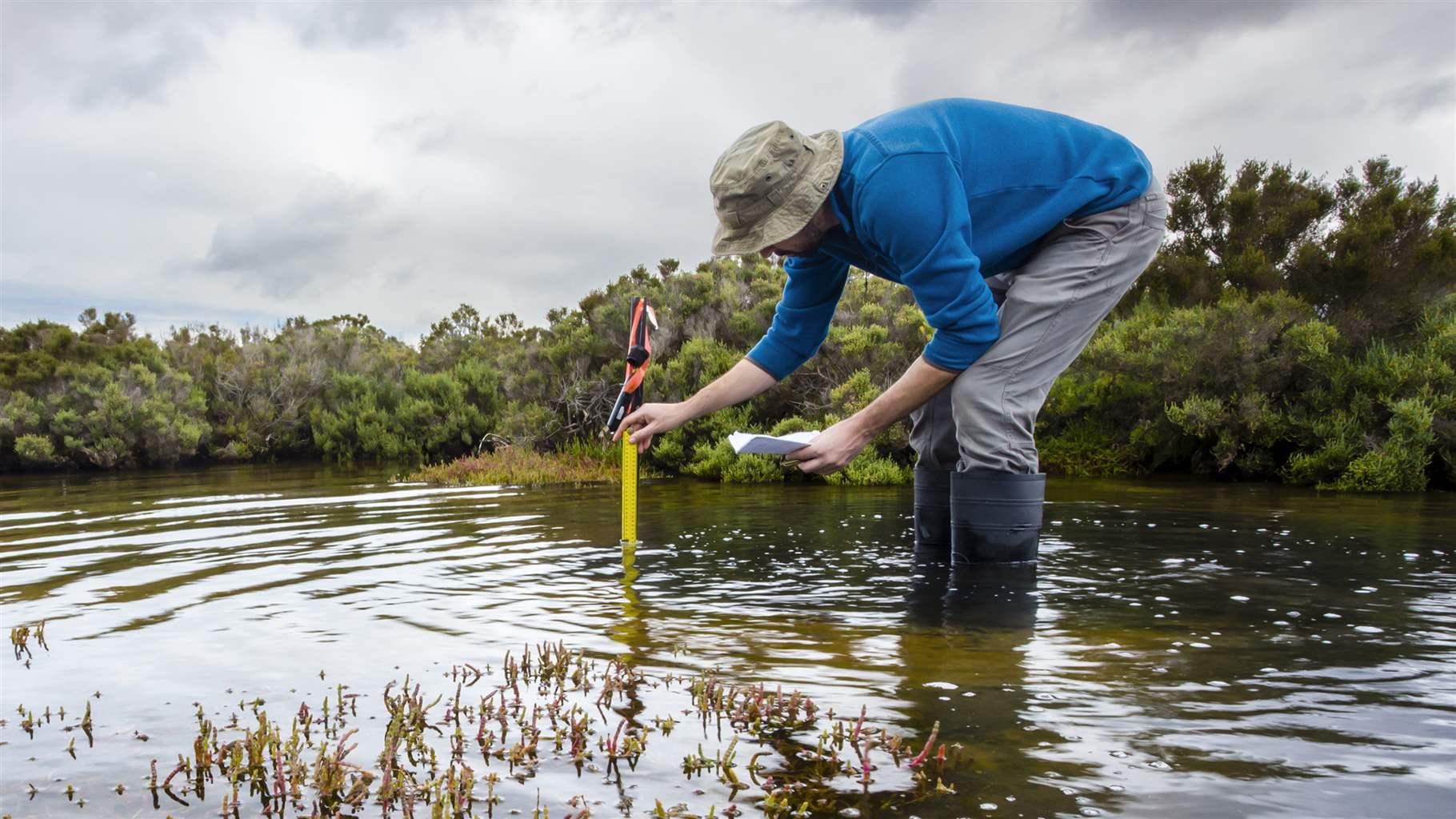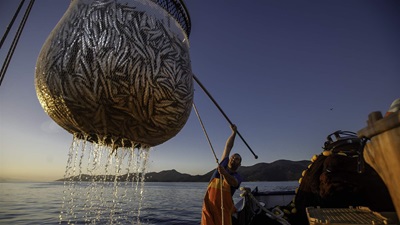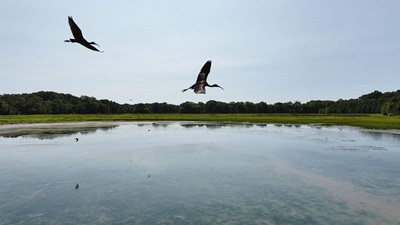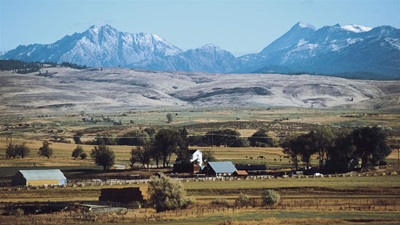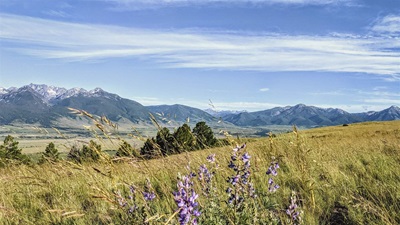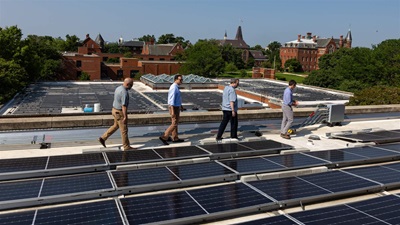Peatlands Play a Vital Ecological and Economic Role in the U.S.
Imperiled habitat sequesters carbon, provides other benefits for communities

Overview
Peatlands are wetland ecosystems that store more carbon than any other natural habitat.1 By removing carbon dioxide from the atmosphere and trapping carbon from dead organic matter in waterlogged conditions, they serve as a critical tool for moderating global temperatures.
When healthy, peatlands—also known as fens, bogs, mires, marshes, pocosins, and swamps—provide enhanced benefits compared with degraded peatlands, including better flood prevention, improved water quality, reduced risk of catastrophic wildfire, and increased cultural and recreational opportunities.2 Protecting healthy peatlands and restoring degraded ones can help sustain these habitats’ many benefits to people and nature.3
The U.S. is home to some of the world’s most extensive peatlands. But over the past two centuries, these important ecosystems have declined significantly in certain regions, including the coastal Southeast, where more than 70% have disappeared because of diking, draining, and conversion to other uses, mainly agriculture.4
To address these challenges, federal and state agencies need to work together to:
- Improve the mapping of peatlands.
- Measure the role of peatlands in reducing carbon pollution.
- Set conservation and restoration targets for these wetlands.
- Implement measures to achieve targets.
What are peatlands?
Peat is a spongy, carbon-rich organic soil that forms when low-oxygen, waterlogged conditions significantly slow the decay of dead plant matter, primarily mosses, sedges, grasses, and other wetland vegetation.5 As dead plant matter accumulates over time, thick peat layers form, typically 6 to 16 feet deep each.6 (See Figure 1.) This process, coupled with local factors such as hydrology, elevation, and vegetation, yields the variety of peatland types, such as bogs (fed by rainfall) and fens (fed by groundwater).7 If left undisturbed, these wetlands accumulate massive amounts of carbon over millennia.
Peatlands are located in coastal and inland environments of tropical, temperate, and polar regions. They cover approximately 3% of the Earth’s surface and store twice as much soil carbon as all the world’s forests combined.8 In the U.S., peatlands are found at virtually all latitudes, with large swaths in Alaska, the Great Lakes region, and Florida.9 (See Figure 2.) The Pew Charitable Trusts is working with partners to better understand the extent of peatlands throughout the U.S. and determine where conservation and restoration efforts would yield the most benefits for reducing carbon pollution.
Benefits for people and nature
Despite occupying just 1.2% of the total land area in the U.S. (approximately 3.7 million square miles), peatlands contain about 20% of the soil-stored carbon in the country—roughly the same amount of carbon as is sequestered annually by 60 billion acres of forests.10
Peatlands offer other essential ecological, cultural, and economic benefits. They have been integral to Indigenous peoples’ traditions for centuries, representing an important aspect of their culture, history, and heritage.11 Peatlands also provide habitat for rare and endangered species, such as the Pocosin Lakes red wolf and the redcockaded woodpecker, and function as natural water regulators, absorbing rainfall in wet periods and enriching water flows during dry spells, which enhances neighboring communities’ resilience to floods, droughts, and wildfires.12 One study estimated that if peatland conservation prevented just one catastrophic wildfire, taxpayers could save more than $3 million.13
In addition, peatlands help maintain a clean water supply necessary for sustaining economically important activities such as fishing and wild rice cultivation and support the recreational economy, including hunting and bird-watching. The Sax-Zim Bog, northwest of Duluth, Minnesota, for instance, attracts bird-watchers from across the country, generating an estimated $1.18 million annually for the local economy.14 (See Figure 3.)
Minnesota's Peatlands
Minnesota is home to the most extensive peatlands in the lower 48 states, which cover approximately 6 million acres—more than 10% of the state—and store an estimated 4 billion metric tons of carbon, equivalent to 27 years’ worth of the state’s annual greenhouse gas emissions.15 Formed more than 5,000 years ago, these ancient wetlands hold peat deposits reaching up to 35 feet deep.16
Drought and other climate impacts, ditching and drainage, and land-use practices that degrade water quality threaten Minnesota’s peatlands.17 Fortunately, Minnesota has recognized the importance of protecting and restoring its extensive peatlands to sustain benefits, such as wildlife habitat, water quality, and carbon storage. The state’s efforts include enacting robust laws to protect its wetlands and investing state funds in the restoration of degraded peatlands.18
To bolster those efforts, as the state updates the Minnesota Climate Action Framework, which lays out the vision and near-term action plan for addressing climate change, it can establish new protection and restoration targets for peatlands. Minnesota can also improve management of state-owned lands to build peatlands’ resilience to drought and other climate stressors. Together, these actions would help to secure the benefits—valued at $324 million annually—that Minnesota receives from its peatlands, support the region’s biodiversity, and protect communities from flooding and wildfire.19
Loss and degradation
Draining of peatlands for agriculture and other uses that began during colonial times has destroyed approximately 4% of peatlands in the U.S., though this percentage probably understates the true losses, as the historical effects of development are not fully captured in mapping records.
The loss of peatlands poses a substantial environmental challenge. As degradation and drainage expose peat soils to air, carbon dioxide is released back into the atmosphere.20 Research shows that degraded peatlands in the U.S. emit about 47 million metric tons of carbon dioxide equivalent each year, similar to the emissions generated by more than 11 million gasoline-powered vehicles driven for an entire year.21 A study that examined degradation of California’s Sacramento-San Joaquin Delta since the 1800s revealed that the region lost roughly 140 million metric tons of previously stored carbon—equivalent to burning half a trillion pounds of coal—largely as a result of diking and draining the region’s peatlands.22
Fully or partially drained peatlands are vulnerable to stressors such as drought and wildfire, which can increase carbon pollution, harm human health, and reduce communities’ protection against floods and fires. 23 For example, the 2008 Evans Road Fire in eastern North Carolina, which occurred in an area of degraded peatlands, cost the state $20 million for fire suppression efforts alone.24 Additionally, poorly planned extractive activities, including mining and certain forestry practices, also pose a threat to intact peatlands, often by damaging the water sources these habitats depend on.25
North Carolina's Pocosins Restoration
Pocosins, a type of peatland characterized by sandy soil and woody shrubs, once spanned the Southeastern U.S. But after extensive ditching, draining, and conversion to agriculture, approximately 1.7 million acres of pocosins in the Southeast have been lost.26
In recent years, a diverse group of stakeholders in North Carolina has undertaken a collaborative effort to restore the state’s drained peat soils, rehabilitating 43,000 acres of pocosins.27 Peatland restoration involves the reversal of drainage to reinstate natural water levels and patterns. This “rewetting” process can transition previously drained peatlands from being sources of carbon dioxide emissions back to their natural state as carbon storers. Recent research indicates that rewetting 111,000 to 200,000 acres of drained pocosins could prevent 4.3 million tons of carbon pollution from escaping into the atmosphere and reduce the risk of catastrophic wildfire, underscoring the importance of peatland restoration in combating climate change and protecting communities.28
Action is needed to conserve and restore peatlands
Protecting existing peatlands and preventing further degradation is imperative to keep their centuries-old carbon stored in the ground and to maintain and expand the myriad benefits these landscapes provide.29 The federal government and states can support these goals by strengthening wetland conservation policies and programs.30
Federal officials can improve national peatland maps and carbon estimates and use that data to prioritize places for conservation and restoration.31 And states can play an important role by conserving and restoring peatlands within their jurisdictions and by enacting laws and implementing policies that address gaps in federal wetland protections. For example, Minnesota’s Wetlands Conservation Act restricts harmful activities such as draining or excavating and promotes restoration of degraded peatland areas. Other potential state actions include investing in better mapping to identify drained peatlands and in restoration wherever feasible.
Conclusion
Conserving and restoring peatlands are critical elements of nature-based strategies that can help people and ecosystems adapt to climate-related impacts. Policies that facilitate protection and restoration, as well as improvements in mapping, can help maintain and expand the many ecological, economic, health, and cultural benefits peatlands provide.
Endnotes
- Sabrina Imbler, “Meet Peat, the Unsung Hero of Carbon Capture,” The New York Times, Feb. 22, 2022, https://www.nytimes.com/interactive/2022/02/21/headway/peat-carbon-climate-change.html.
- Dale H. Vitt, “Peatlands of Continental North America,” in The Wetland Book: II: Distribution, Description, and Conservation, eds. C. Max Finlayson et al. (Dordrecht: Springer Netherlands, 2018), https://doi.org/10.1007/978-94-007-4001-3_105.
- Jens Leifeld and Lorenzo Menichetti, “The Underappreciated Potential of Peatlands in Global Climate Change Mitigation Strategies,” Nature Communications 9, no. 1 (2018): 1071, https://doi.org/10.1007/978-94-007-4001-3_105.
- Dan J. Charman et al., “Assessment on Peatlands, Biodiversity and Climate Change,” Global Environment Centre and Wetlands International, 2008, 99-117, https://www.researchgate.net/publication/284054686_Peatlands_and_carbon. Curtis J. Richardson, Neal E. Flanagan, and Mengchi Ho, “The Effects of Hydrologic Restoration on Carbon Budgets and GHG Fluxes in Southeastern U.S. Coastal Shrub Bogs,” Ecological Engineering 194 (2023): 107011, https://www.sciencedirect.com/science/article/pii/S0925857423001209.
- Dan J. Charman et al., “Assessment on Peatlands.”
- Curtis J. Richardson, Neal E. Flanagan, and Mengchi Ho, “The Effects of Hydrologic Restoration on Carbon Budgets and GHG Fluxes.”
- Dale H. Vitt, “Peatlands of Continental North America.”
- Hans Joosten, “The Global Peatland CO2 Picture: Peatland Status and Emissions in All Countries of the World,” Wetlands International, 2009, https://unfccc.int/sites/default/files/draftpeatlandco2report.pdf. Jiren Xu et al., “PEATMAP: Refining Estimates of Global Peatland Distribution Based on a Meta-Analysis,” CATENA 160 (2018): 134-40, https://www.sciencedirect.com/science/article/pii/S0341816217303004. Julie Loisel et al., “Expert Assessment of Future Vulnerability of the Global Peatland Carbon Sink,” Nature Climate Change 11, no. 1 (2021): 70-77, https://doi.org/10.1038/s41558-020-00944-0.
- Liam Krause et al., “Impacts of Historical Ditching on Peat Volume and Carbon in Northern Minnesota USA Peatlands,” Journal of Environmental Management 296 (2021): 113090, https://www.sciencedirect.com/science/article/pii/S030147972101152X. Christopher B. Craft and Curtis J. Richardson, “Relationships Between Soil Nutrients and Plant Species Composition in Everglades Peatlands,” Journal of Environmental Quality 26, no. 1 (1997): 224-32, https://doi.org/10.2134/jeq1997.00472425002600010032x.
- Scott D. Bridgham et al., “The Carbon Balance of North American Wetlands,” Wetlands 26, no. 4 (2006): 889-916, https://doi.org/10.1672/0277-5212(2006)26[889:TCBONA]2.0.CO;2. Point Blue Conservation Science, “Evidence for the Multiple Benefits of Wetland Conservation in North America: Carbon, Biodiversity, and Beyond,” 2022, https://www.nrdc.org/sites/default/files/evidence-multiple-benefits-wetlands-conservation-report-202301.pdf. U.S. Environmental Protection Agency, “Greenhouse Gas Equivalencies Calculator,” accessed April 2023, https://www.epa.gov/energy/greenhouse-gas-equivalencies-calculator.
- Jeffrey Speller and Véronique Forbes, “On the Role of Peat Bogs as Components of Indigenous Cultural Landscapes in Northern North America,” *Arctic, Antarctic, and Alpine Research* 54, no. 1 (2022): 96-110, https://doi.org/10.1080/15230430.2022.2049957.
- “Pocosin Lakes National Wildlife Refuge,” U.S. Fish & Wildlife Service, https://www.fws.gov/refuge/pocosin-lakes/what-we-do.
- Bryan Parthum, Emily Pindilli, and Dianna Hogan, “Benefits of the Fire Mitigation Ecosystem Service in the Great Dismal Swamp National Wildlife Refuge, Virginia, USA,” *Journal of Environmental Management* 203 (2017): 375-82, https://www.sciencedirect.com/science/article/pii/S0301479717307958.
- “Sax-Zim Bog: A Magic Mix,” Friends of Sax-Zim Bog, https://saxzim.org/about-sax-zim-bog/.
- Abby Rogerson, “Real Climate Solutions Protect Peatlands,” Minnesota Center for Environmental Advocacy, May 26, 2022, https://www.mncenter.org/real-climate-solutions-protect-peatlands.
- Jennifer Bjorhus, “A Climate Conundrum Beneath Our Feet: Minnesota’s Farmed Peat Soil Releases Greenhouse Gases,” Feb. 12, 2022, https://www.startribune.com/a-climate-conundrum-beneath-our-feet-minnesotas-farmed-peat-soil-releases-greenhouse-gases/600146107/?refresh=true.
- Liam Kruse et al., “Impacts of Historical Ditching on Peat Volume and Carbon in Northern Minnesota USA Peatlands.”
- Minnesota Department of Natural Resources, “Minnesota Scientific and Natural Areas Patterned Peatlands,” accessed Aug. 26, 2024, https://www.dnr.state.mn.us/snas/peatlands.html.
- Erin Mackey, “The Economic Benefits of Natural Climate Solutions in Minnesota,” The Nature Conservancy, 2023, https://www.nature.org/content/dam/tnc/nature/en/documents/EarthEconomics_2023EconomicBenefitsofNaturalClimateSolutions.pdf.
- Jens Leifeld, Chloé Vuist-Galley, and Susan Page, “Intact and Managed Peatland Soils as a Source and Sink of GHGs from 1850 to 2100,” *Nature Climate Change* 9, no. 12 (2019): 945-47, https://doi.org/10.1038/s41558-019-0615-5.
- Dianna Kopansky et al., “Global Peatlands Assessment—The State of the World's Peatlands: Evidence for Action Toward the Conservation, Restoration, and Sustainable Management of Peatlands,” United Nations Environmental Programme, 2022, https://www.unep.org/resources/global-peatlands-assessment-2022.
- Vaughn Lydia et al., “Delta Wetland Futures: Blue Carbon & Elevation Change,” San Francisco Estuary Institute-Aquatic Science Center, 2022, https://www.sfei.org/sites/default/files/biblio/2024-08/DeltaWetFutures_BlueCarbonElevationChange_v4pt2_EmbeddedImagesADA_v5.pdf.
- Robert A. Mickler, David P. Welch, and Andrew D. Bailey, “Carbon Emissions During Wildland Fire on a North American Temperate Peatland,” *Fire Ecology* 13, no. 1 (2017): 34-57, https://doi.org/10.4996/fireecology.1301034.
- Robert A. Mickler, David P. Welch, and Andrew D. Bailey, “Carbon Emissions During Wildland Fire on a North American Temperate Peatland.”
- Dianna Kopansky et al., “Global Peatlands Assessment—The State of the World’s Peatlands.”
- Curtis J. Richardson et al., “Annual Carbon Sequestration and Loss Rates Under Altered Hydrology and Fire Regimes in Southeastern USA Pocosin Peatlands,” *Global Change Biology* 28, no. 21 (2022): 6370-84, https://doi.org/10.1111/gcb.16366.
- “Pocosin Lakes National Wildlife Refuge,” U.S. Fish & Wildlife Service.
- Curtis J. Richardson et al., “Annual Carbon Sequestration and Loss Rates Under Altered Hydrology and Fire Regimes.”
- Point Blue Conservation Science, “Evidence for the Multiple Benefits of Wetland Conservation in North America.”
- Florian Humpenöder et al., “Peatland Protection and Restoration Are Key for Climate Change Mitigation,” *Environmental Research Letters* 15, https://iopscience.iop.org/article/10.1088/1748-9326/abae2a.
- Dianna Kopansky et al., “Global Peatlands Assessment—The State of the World’s Peatlands.”

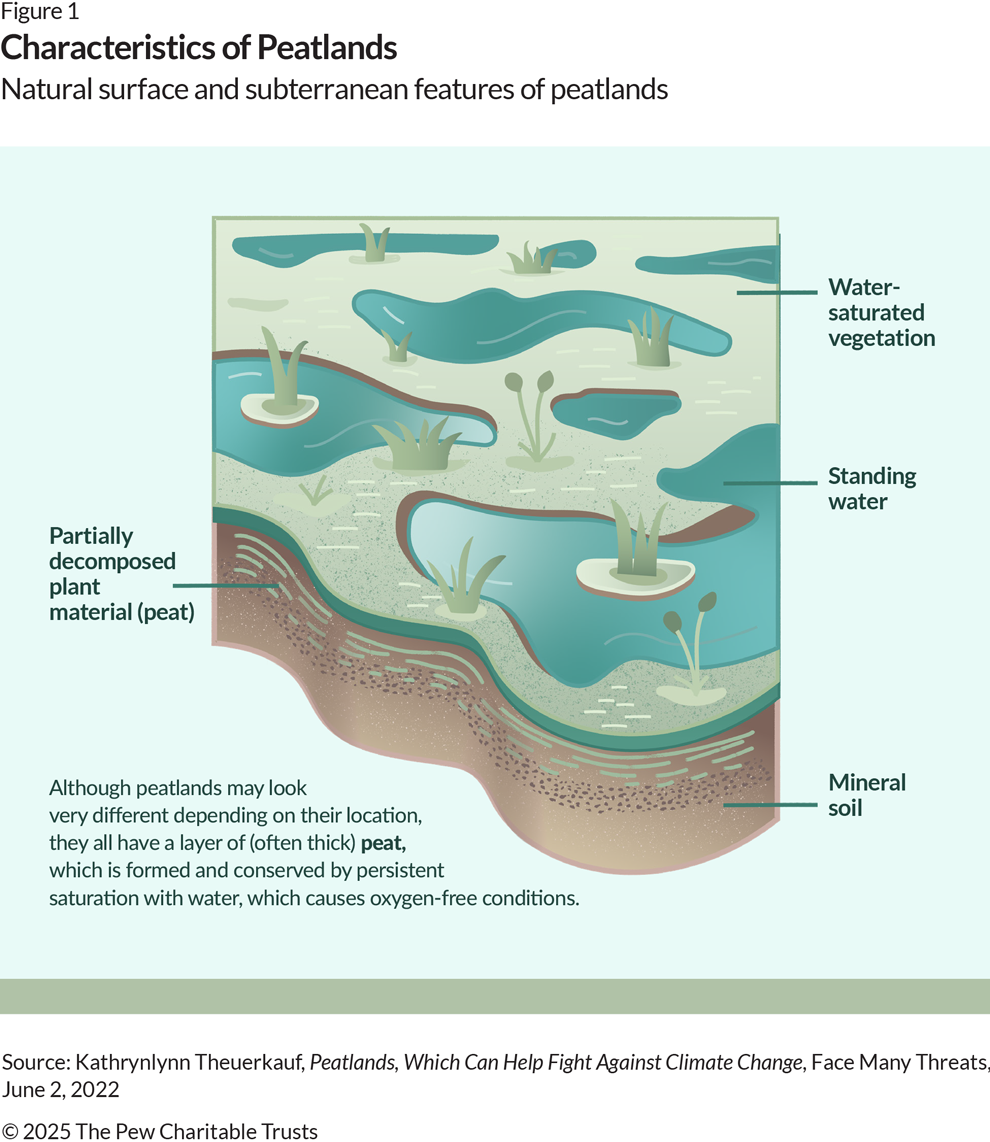
.jpg)
